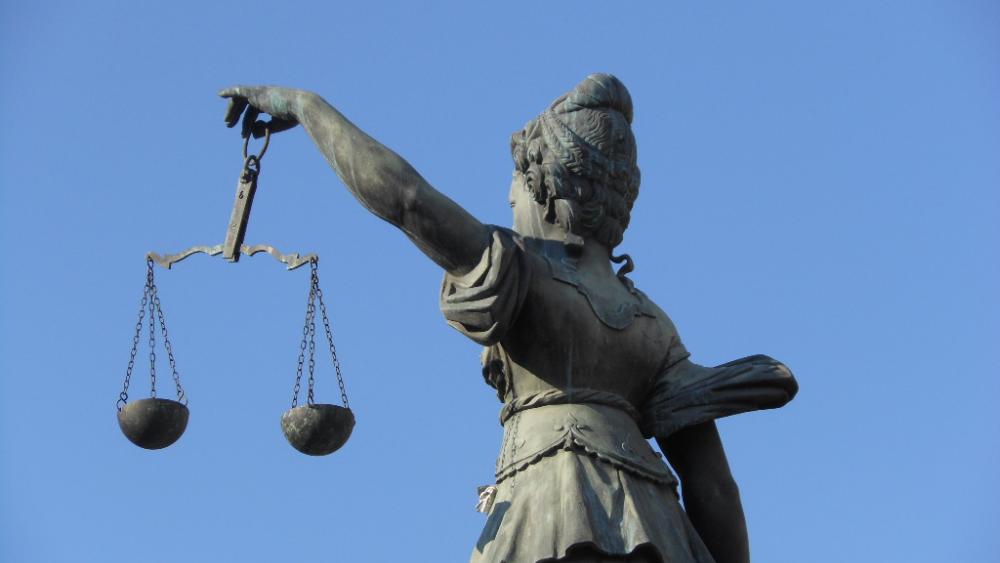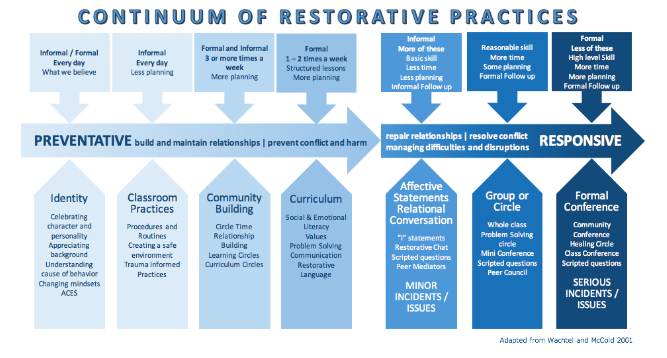Using Restorative Justice to Build School Community
Guest blog by Noelle Hobbs with content support from Maureen Klein and Katelyn Herrygers
Your class is working silently on a group project when all of a sudden you hear a loud “ow” from a student. It appears that Sam has thrown a marker right at Riley’s head. Riley is crying, the other students are all staring at the situation at hand, and in the matter of moments the entire class environment has shifted.
Think about your personal experience with a student who misbehaved in school. What happened to the child; were they punished? How did the other students react in that situation? And most importantly, did the behavior change?
The above are concerns that all teachers and parents probably have when it comes to potentially harmful behavior in schools. A trending solution to misbehavior is restorative justice, which is a facet of social-emotional learning (SEL). This strategy “focuses on building relationships and repairing harm, rather than simply punishing students for misbehavior.” Most notably, the Oakland Unified School District began using a restorative justice program at a middle school in 2006. Within three years, the school saw a decrease in suspensions by 87 percent, with a corresponding decrease in violence.
It is also important to note that restorative justice can help eliminate bias punishments. It has been found that the typical response to suspend or expel has led to disproportionate numbers of students of color being punished. Not only does this have a direct effect on the child, but it also impacts the classroom community and the students’ relationship with their teacher. Instead of punishment for wrong doing or misbehavior, maybe an answer is in helping students understand who they are and how they are part of a community.
Examples of Restorative Justice in Practice
In an elementary classroom setting, 20-30 students will spend more waking time together Monday through Friday than they will with their families. Conflicts are bound to happen. Our response as classroom teachers has the power to either escalate or deescalate the conflict. By modeling informal restorative practices, Teachers can teach the language of conflict resolution by modeling informal restorative practices and using affective statements aimed at building relationships as well as addressing negative behavior non-judgmentally in whole-class reteaching.
Alex is a very bright, excited student. He frequently disrupts classroom discussion and or directions. In a more traditional behavior model, the teacher would implement a negative consequence for the behavior (for example, "card flips" or loss of privilege or recess time). Using restorative practices, the teacher has a private conversation with Alex in which they review classroom expectations and discuss the importance of listening and not blurting out. This gives Alex the opportunity to see his role in the classroom community. He isn't naughty, but his enthusiasm isn't allowing everyone to have a chance to think for themselves, come up with their own ideas/answers, and listen to all directions. The teacher can work with Alex privately to come up with ideas to help build his self-control (for example, taking three breaths before speaking, giving a thumbs-up when he has an idea, or writing his thoughts on sticky notes).
Several girls in the class have been intentionally excluding other students in the lunchroom. In an effort to sit with their "best" friends, they have been telling others that they cannot join them. The hurtful behavior escalated to the point of yelling and crying in the lunch room. In a more traditional behavior model, the students involved in the incident would be sent to the principal's office where negative consequences would be implemented. Using restorative practices, the teacher first seeks to understand the situation from each student's perspective. This may be through speaking individually to the students or by asking each to write a letter describing what took place (which often points out the root cause beyond the one incident). Asking each student involved what they can do to help repair the relationships shifts the external adult-directed response to an individual, internal, student-led response. The lunchroom incident can also be addressed through a class meeting. Class meetings provide an opportunity to practice positive language and relationship skills, review classroom expectations, and celebrate moments of kindness and inclusion. In the class meeting, the teacher refocuses and reinforces expected behavior holistically with a goal toward strengthening community, not punishing individuals.
(Image credit Common Justice.org)
Building Community
Implementing restorative justice practices doesn’t require a major overhaul of classroom procedures. Use the following resources to teach students about relationships, bullying, respect, and justice as a foundation.
-
Community Building
-
Creating Student-Generated Classroom Rules: Start the year off by having students participate in creating classroom rules to practice self-government and determine the success of the community as a whole.
-
Blue Sky Envisioning Activity: This group envisioning activity helps you get to know your students and what they care about. The students understand themselves and their community and imagine a better world by discussing the steps they can take.
-
Teamwork Skills: These activities and games help to build community, trust, and communication within the classroom.
-
Morning Meetings: Use any or all of these 14 different types of morning classroom meeting ideas to build empathy and community.
-
-
Anti-bullying
-
Anti-bullying Lessons: Teach students to be proactive by understanding patterns of bullying behavior and making plans to set up a more positive school culture.
-
-
Justice
-
What is Justice?: Students compare the meaning of justice with fairness and distinguish the meanings of fair, just, and equitable.
-
Stand and Deliver for Justice and Diversity: Learners explore and share their attitudes about diversity and issues of justice and kindness. Then, they brainstorm ways that they can promote the common good by working to eliminate stereotyping, intolerance, discrimination, and prejudice.
-
-
Respect
-
We Define Respect: Learners define respect first without any input from the teacher or class discussion. Then as a group, they discuss the meaning of respect and differentiate it and contrast it with disrespectful behavior to self and others.
-
Character Education: Respect: Learners define respect and explore the meaning of self-respect and respect for others while looking for opportunities to demonstrate respect to improve the relationships in their lives and communities.
-
Difficult Conversations: Tips and resources about addressing challenging issues in the classroom. These guidelines help to establish a safe environment, promote respectful dialogue, back up arguments with facts, and talk about news and current events with students.
-
Resolving Conflict with Respect: Teach students the importance of diversity in the community by having students respond to scenarios of differences in opinion. They learn to communicate respectfully with someone of a different opinion and to seek common ground or compromise.
-
Contributing to the Outside Community
The heart of restorative justice is repairing relationships. Instead of handing out a punishment, encourage your class to work together to complete service projects that benefit the community. This guides the student, or students, who acted out to work on rebuilding their relationship with their class and the outside community. It shows that although they may have made a mistake, they still have the ability to make a positive difference. These resources and lessons lead students to service-learning projects that help their local community.
- The Four Types of Service: Teach students that service may be direct, indirect, advocacy, research, or a combination of these to expand their ideas of what they can do. Then, use those types as a basis for developing a service project supporting a community need.
- Issue Areas: Lesson plans and project ideas relating to issue areas, such as relating to refugees, animal advocacy, hunger, and clean water.
- Service to the Neighborhood: Students explore the concept of social responsibility and create art to build connections with “neighbors.”
- Long-Distance Service: Students choose, plan, implement, and evaluate a service project. They work cooperatively with their pen pals and communicate through writing.
There is no detention in the workforce. A restorative justice and SEL approach can help K-12 students and prepare them for their future careers. These practices help students to understand the consequences of their actions and why rules and directions exist, which results in building a stronger community. Communication is key in restorative justice and allows teachers to focus on engaging students heads and hearts.
Additional Resources on Restorative Justice
- Restorative Justice: Resources for Schools
- Implementing Restorative Practices In The Classroom
- 8 Tips for Schools Interested in Restorative Justice

